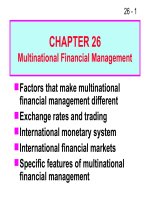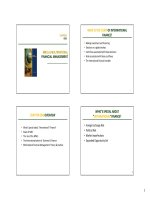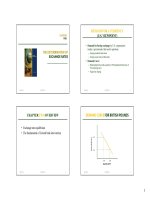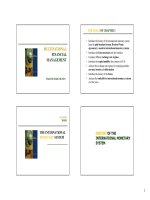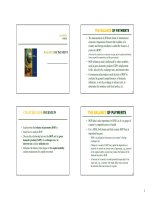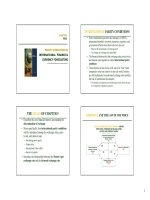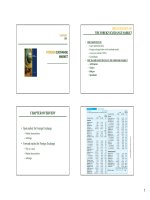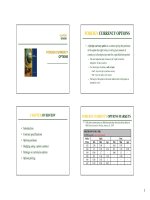Multinational financial management 7th CH10
Bạn đang xem bản rút gọn của tài liệu. Xem và tải ngay bản đầy đủ của tài liệu tại đây (1.02 MB, 46 trang )
Multinational Financial
Management
Alan Shapiro
7th Edition
J.Wiley & Sons
Power Points by
Joseph F. Greco, Ph.D.
California State University, Fullerton
1
CHAPTER 10
MEASURING
ACCOUNTING
EXPOSURE
2
CHAPTER OVERVIEW
I.
ALTERNATIVE MEASURES OF
FOREIGN EXCHANGE EXPOSURE
II.ALTERNATIVE CURRENCY
TRANSLATION METHODS
III.
STATEMENT OF FINANCIAL
ACCOUNTING STANDARDS NO.52
3
CHAPTER OVERVIEW (con’t)
IV. TRANSACTION EXPOSURE
V.
DESIGNING A HEDGING
STRATEGY
VI. MANAGING TRANSLATION
EXPOSURE
VII. MANAGING TRANSACTION
EXPOSURE
4
PART I. ALTERNATIVE MEASURES OF
FOREIGN EXCHANGE EXPOSURE
I. ALTERNATIVE MEASURES OF FOREIGN
EXCHANGE EXPOSURE
A. Three Types of Exposure
1. Accounting Exposure:
when reporting and
consolidating
financial
statements requires
conversion from foreign to local currency.
5
ALTERNATIVE MEASURES OF FOREIGN
EXCHANGE EXPOSURE
2. Transaction Exposure:
occurs from changes in the
value of foreign currency
contracts as
a result of
exchange rate
changes.
6
ALTERNATIVE MEASURES OF FOREIGN
EXCHANGE EXPOSURE
3. Operating Exposure
arises because exchange rate
changes may alter the value of
future revenues and costs.
7
ALTERNATIVE MEASURES OF FOREIGN
EXCHANGE EXPOSURE
Economic Exposure
= Transaction + Operating
Exposures
8
PART II. ALTERNATIVE CURRENCY
TRANSLATION METHODS
I. FOUR METHODS OF TRANSLATION
A. Current/Noncurrent Method
1. Current accounts use
current exchange rate for
conversion.
2. Income statement accounts
use average exchange
rate
for the period.
9
ALTERNATIVE CURRENCY
TRANSLATION METHODS
B. Monetary/Nonmonetary Method
1. Monetary accounts use
current rate
2. Pertains to
- cash
- accounts receivable
- accounts payable
- long term debt
10
ALTERNATIVE CURRENCY
TRANSLATION METHODS
3.
4.
Nonmonetary accounts
- use historical rates
- Pertains to
inventory
fixed assets
long term investments
Income statement accounts
- use average exchange rate
for the period.
11
ALTERNATIVE CURRENCY
TRANSLATION METHODS
C. Temporal Method
1. Similar to
monetary/nonmonetary
method.
2. Uses current method for
inventory.
12
ALTERNATIVE CURRENCY
TRANSLATION METHODS
D.
Current Rate Method
all statements use current
exchange rate for conversions.
13
PART III. STATEMENT OF INANCIAL
ACCOUNTING STANDARDS NO. 52
I. FASB NO. 52
A. Dissatisfaction with FASB No. 8
true profitability often disguised by
exchange rate volatility.
B. Balance sheet translation uses
current rate method.
14
STATEMENT OF INANCIAL ACCOUNTING
STANDARDS NO. 52
C.
Income statement uses
1. Weighted average rate
during period
or
2.
The rate in effect when
revenue and expenses
incurred.
15
STATEMENT OF FINANCIAL
ACCOUNTING STANDARDS NO. 52
D. Translation Gains or Losses
1. Recorded in separate equity
account
on balance sheet.
2. Known as cumulative
adjustment
translation
account.
16
STATEMENT OF INANCIAL ACCOUNTING
STANDARDS NO. 52
E. New Distinction under FASB No. 52:
functional v. reporting currency
1. Functional currency
for foreign subsidiary = the
currency used in the
primary
economic
environment in which it
operates.
17
STATEMENT OF INANCIAL ACCOUNTING
STANDARDS NO. 52
2. Reporting currency
the currency the parent firm
uses to prepare its financial
statements.
18
STATEMENT OF FINANCIAL
ACCOUNTING STANDARDS NO. 52
3.
If foreign subsidiary’ operations are
direct extension of parent firm
e.g. Hong Kong assembly plant
which
sells all its products in the U.S.
market.
19
PART IV. TRANSACTION EXPOSURE
I. WHEN DOES IT OCCUR?
A. From the time of agreement to time of
payment.
B. Arises from possibility of exchange rate
gains and losses from the transaction.
20
TRANSACTION EXPOSURE
II. MEASUREMENT
A. Currency by currency
B. Equals the difference between
1.
The contractually-fixed invoice
amount in a specific currency
2.
The final payment amount
denominated in current
exchange
rate for the specific currency.
21
PART V. DESIGNING A HEDGING
STRATEGY
III. DESIGNING A HEDGING STRATEGY
A. Strategies
a function of management’s
objectives
B. Hedging’s basic objective:
reduce/eliminate volatility of
earnings as a result of exchange
rate changes.
22
DESIGNING A HEDGING
STRATEGY
C. Hedging exchange rate risk
1. Costs money
2. Should be evaluated as any
other
purchase of insurance.
3. Taking advantage of tax
asymmetries lowers hedging
costs.
23
DESIGNING A HEDGING
STRATEGY
D. Centralization v. Decentralization
1.
Important aspects:
a.
Degree of centralization
b.
Responsibility for developing
c.
Implementing the hedging
strategy.
2.
Maximum benefits accrue from
centralizing policy-making,
formulation, and
implementation.
24
PART VI. MANAGING TRANSLATION
EXPOSURE
I. MANAGING TRANSLATION EXPOSURE
A. 3 Available Methods
1. Adjusting fund flows
altering either the amounts or the
currencies of the planned cash
flows of the parent or its
subsidiaries to reduce the firm’s
local currency accounting
exposure.
25
